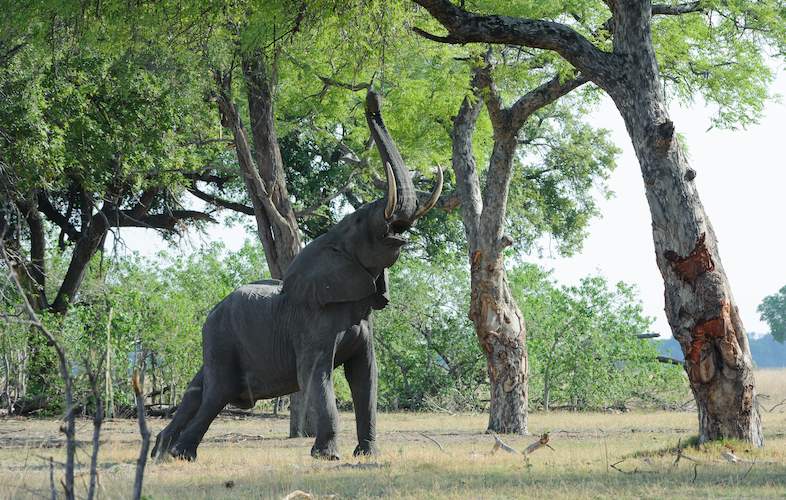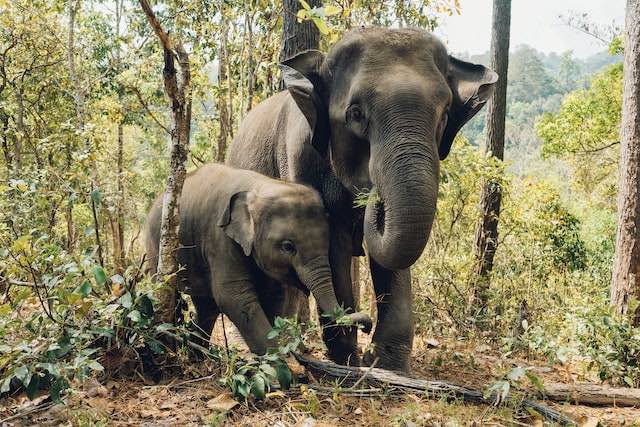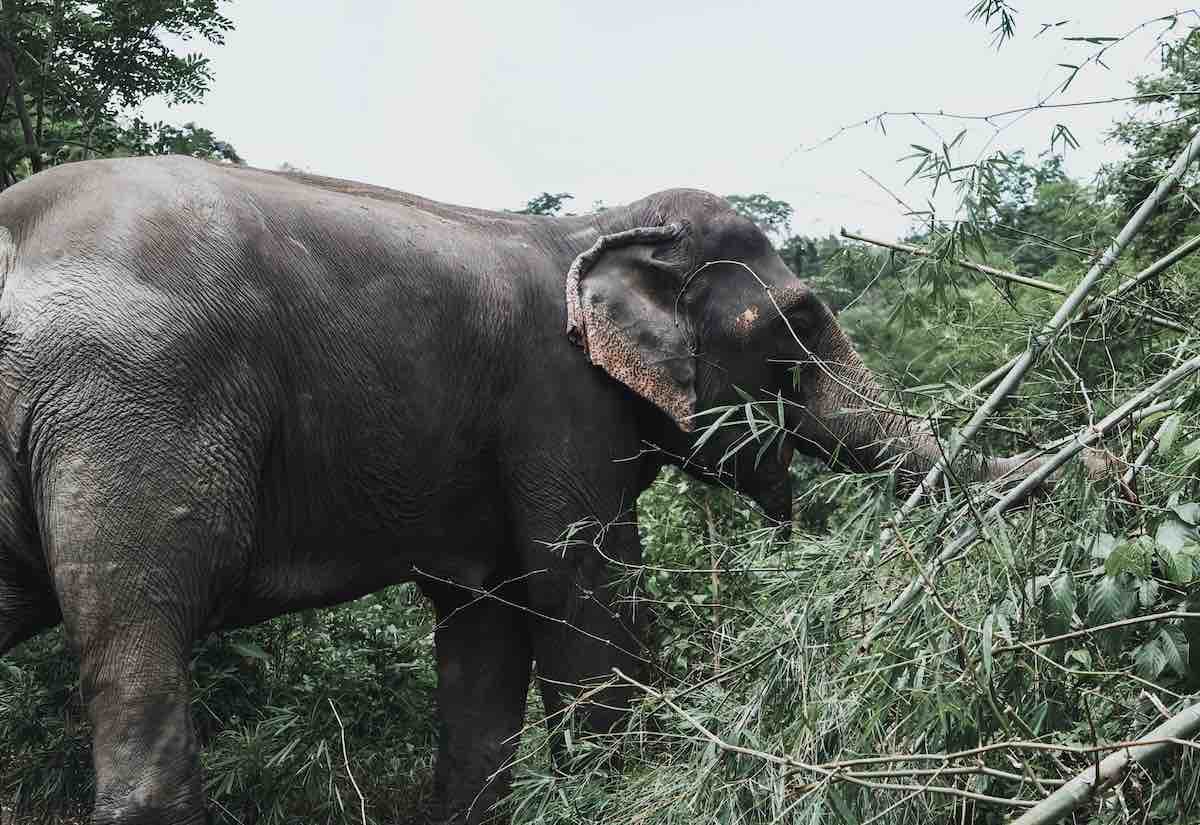Have you ever been so frustrated with something that you just wanted to take it out on the nearest tree?
Elephants seem to have the same problem – except they’re much bigger and stronger meaning that when they do push over trees – they actually fall.
From agricultural fields to forests and even urban areas, elephants are known for their destructive tendencies regarding trees. Why is it that elephants destroy trees?
With an uncanny ability to find the most nourishing parts of trees, elephants have developed a habit of breaking tree trunks for easy access.
This gives them quick and effortless access to leaves, roots, and all essential nutrients available within the plant.
In this article, we’ll look at some environmental and anthropogenic factors contributing to elephant-tree destruction and discuss potential solutions.
We’ll also debunk some myths surrounding this issue to understand better what’s happening here.
Environmental Factors Contributing to Elephant-Tree Destruction
Elephants rely heavily on trees for food, shelter, and moisture. Unfortunately, as their natural habitats shrink due to human encroachment, elephants conflict with humans over resources – trees included!
As a result, these animals often destroy the things they need for survival. Deforestation is another major factor in elephant-tree destruction as it reduces the available resources and forces elephants to look elsewhere for food.
Elephants are also known to known down certain tree species, thus depleting them completely.
Anthropogenic Factors Contributing to Elephant-Tree Destruction
While environmental factors play a role in elephant-tree destruction, anthropogenic (or human-caused) elements contribute to this phenomenon as well.
One of the most common is illegal logging, which reduces the availability of trees and causes elephants to search for food in other areas.
Human settlements near forests also influence elephant movement patterns and force elephants into closer contact with humans, leading to increased conflict and thus also destruction of more trees.
Lastly, some African cultures encourage the destruction of trees for elephant control; this practice has been linked to increased behavior of elephants destroying trees.

Effects of Elephant-Tree Destruction on the Environment
The destruction of trees by elephants can have a devastating impact on the environment. Some of the more visible are:
1. Deforestation
One of the most significant effects of elephants destroying trees is deforestation.
When elephants uproot trees or break them apart, they beat the natural habitat other animals rely on for shelter and food.
This can lead to a decrease in biodiversity and an increase in greenhouse gas emissions, as trees are no longer present to absorb carbon dioxide from the atmosphere.

2. Soil Erosion
Another effect of elephants destroying trees is soil erosion. When trees are uprooted or broken, the roots that once held them in place are no longer present.
This can cause the soil to become loose and erode more efficiently, leading to a loss of topsoil and decreased fertility.
Soil erosion can also increase the risk of flooding as there is less vegetation to slow down the flow of water.
3. Climate Change
Deforestation and soil erosion can also contribute to climate change. As mentioned above, when trees are removed from an area, they are no longer present to absorb carbon dioxide from the atmosphere.
This can cause an increase in greenhouse gas emissions, which can trap heat in the atmosphere and lead to global warming.
Additionally, soil erosion can lead to a decrease in vegetation, which can reflect less sunlight and also contribute to climate change.
4. Human Health Issues
The effects of elephants destroying trees can also extend to human health issues. For example, a decrease in vegetation due to soil erosion can lead to dust storms, which can cause respiratory problems for people who breathe in the dust particles.
Additionally, if there is a decrease in biodiversity due to deforestation, in that case, this can lead to a loss of food sources for humans as well as an increase in the spread of disease.
Steps That Can Be Taken to Reduce or Prevent Elephant From Destroying Trees
Elephants destroy trees, as its a part of their eating routine. But we can take several steps to reduce or prevent it.
1. Providing Them With an Alternative Food Source
One way to prevent elephants from destroying trees is by providing them with an alternative food source.
Elephants are herbivores, and their diet consists mainly of woody vegetation and plant species.
If there is a lack of food, they will often turn to trees as a source of nourishment. By providing them with a reliable food source, you can help reduce the damage they cause to trees.
2. Creating A Barrier Between Them And The Trees
Another way to prevent elephants from destroying trees is by creating a barrier between them and the trees elephants knock over.
This can be done by fencing off areas where large trees are growing or by planting thorny bushes around the area’s perimeter. This will deter elephants from entering the area and help protect the trees.
3. Tranquilizing Them
If elephants are causing extensive damage to trees, they may need to be tranquilized to prevent further destruction. This should only be done as a last resort and should only be done by trained professionals.
Once the mature elephant bull has been tranquilized, it can be moved to another location where it will not have access to the same amount of tree cover, or at least protected species.
4. Relocating Them
If elephants consistently damage trees in a particular area, they may need to be relocated to another area with fewer trees.
This will help to reduce the amount of damage they cause and will also help to protect the local savanna ecosystems.
5. Educating People About Their Behavior
One of the best ways to prevent elephants from destroying trees is by educating people about elephant behaviors. Many people are unaware of the damage that elephants can cause to trees and other vegetation.
By educating people about this issue, you can help to raise awareness and ultimately help to reduce the amount of damage that elephants cause.
Myths and Misconceptions Surrounding Elephant-Tree Destruction
One of the most common myths about elephant-tree destruction is that it is a result of elephants being angry or aggressive. While this may be true in some cases, it is not necessarily valid for all instances.
In reality, if we take Kruger National Park as an example; their elephant bulls are usually attracted to trees because they need food and shelter – not because they are mad! Another myth surrounding this issue is that it can only occur in Africa.
While most cases of elephant-tree destruction occur in Africa, they can also occur in other parts of the world.
Final Thoughts On Why Elephants Destroy Trees
Elephants’ often disastrous behaviors towards trees are due to a variety of environmental and human causes. This phenomenon can have devastating results on the natural world, such as soil erosion and decreased biodiversity.
However, there are practical ways to reduce and prevent elephant-tree conflicts, such as creating alternative food sources, using physical barriers, and educating people about the issue.
Additionally, it is necessary to challenge established narratives in order to gain a full comprehension of this problem. Notably for wildlife lovers and conservationists, herbivores played an important role before humans intervened by effectively regulating the growth of trees which created diverse habitats across different regions.
Protecting elephants and trees is critical to maintaining a balanced ecosystem, and we should take proactive measures to ensure the elephant population is protected and growing.
FAQs about Why Elephants Destroy Trees
Elephants may destroy trees for various reasons, including seeking food, marking their territory, or stripping bark for medicinal purposes.
Elephants can damage trees in several ways, such as pushing them over, breaking branches, or stripping bark with their tusks.
There are several methods to prevent or mitigate elephant-tree conflicts, including using physical barriers, implementing deterrent measures, or creating alternative food sources.
Yes, there are several other factors that can contribute to tree destruction, such as climate change, deforestation, logging, or agricultural expansion. These factors can also impact elephant populations and their habitat.
